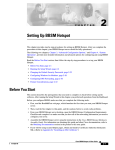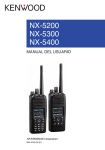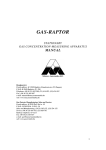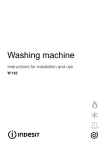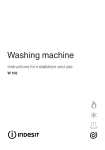Download Cisco Systems Document ID: 15942 Server User Manual
Transcript
Level Two Technical Support for BBSM Document ID: 15942 Introduction Prerequisites Requirements Components Used Conventions Software Requirements Software Application Description BBSM End User Supported Ethernet Network Interface Cards Troubleshooting BBSM Users are Unable to Send or Receive E−Mail IIS Proxy LAT Setup (BBSM 5.0 only) PMS Does Not Post Charges End Users Redirected to RadiusClearFail.asp Regroom Problems RME 19+7 − "Sorry, a network error has occurred" Error Message Switches Are Unresponsive URL Error Page NetPro Discussion Forums − Featured Conversations Related Information Introduction The Cisco Building Broadband Service Manager (BBSM) is a subscriber management software package for a public local−area network (LAN) server that provides "an Internet Service Provider (ISP) in a box". For end users in the network, Cisco BBSM provisions, tracks, and provides billing support for access to the Internet. The BBSM software is provided on a server. BBSM consists of a dedicated server, usually located at this site, as well as switches, routers, and cables to connect each end user port to the server. The end user connects to the server when the user connects to an end user port. When a Web browser such as Internet Explorer or Netscape Communicator is opened, the browser automatically searches for Internet access. The browser finds the BBSM Welcome page, which indicates a connection to the BBSM server but not to the Internet. At this point, the BBSM software has already identified the Media Access Control (MAC) address of the end user's computer, queried all switches on the network in order to determine the location of the end user, and assigned a temporary IP address to the end user's location. After you press the Connect button, the BBSM software designates the end user port as active. If relevant, billing information is processed for that end port. The end user now has a connection to the Internet. This figure shows a typical BBSM configuration. Cisco − Level Two Technical Support for BBSM Prerequisites Requirements There are no specific requirements for this document. Components Used This document is not restricted to specific software and hardware versions. The information in this document was created from the devices in a specific lab environment. All of the devices used in this document started with a cleared (default) configuration. If your network is live, make sure that you understand the potential impact of any command. Conventions Refer to Cisco Technical Tips Conventions for more information on document conventions. Software Requirements Before you troubleshoot, verify that user equipment meets the basic requirements for BBSM: BBSM Compatible Client Operating Systems/Versions Cisco − Level Two Technical Support for BBSM Microsoft Apple Windows Me Macintosh OS 9, X Windows CE Linux Red Hat Linux 6.1 − 7.1 Windows NT 4.0 Workstation Windows NT 4.0 Server Open BSD Turbo Linux Windows NT 4.0 Enterprise Server Solaris Windows 2000 Professional Versions 7 and 8 Windows 2000 Server Windows 2000 Advanced Server BEOS BEOS Version 4.5 or higher Note: The configuration of advanced services such as Domain Name System (DNS), Interim−Interswitch Signaling (IIS), and Dynamic Host Configuration Protocol (DHCP) on a server product can cause conflicts that result in connection problems. BBSM 5.0 Server Software • Windows 2000 Server CD • Cisco BBSM 5.0 CD • Microsoft Proxy Server 2.0 CD BBSM 5.1 Server Software • Windows 2000 Server CD • Cisco BBSM 5.1 CD • Microsoft Industry−Standard Architecture (ISA) Server Software Application Description Software Applications AtNat • Provides plug and play (bridged network) • Redirects clients before authentication • Provides Network Address Translation (NAT) for static clients • Emulates Web proxy MSDE MSDE is the database used in order to store necessary informtion for BBSM. BBSM Access Allows billing methods and access policies Cisco − Level Two Technical Support for BBSM Policy IIS Provides Web services Proxy 2.0 ISA Server MSMQ AtDial Athdmn DHCP Server DNS Server Proxy support for BBSM 5.0 Proxy support for BBSM 5.1 Provides data transport between IIS and MSDE Core Service of BBSM software Sends billing information to the Property Management System (PMS) server Provides non−static clients with IP addresses and related information Transcribes a fully−qualified domain name to an IP address; for example, www.cisco.com to198.133.219.25 X.Y designates the release numbers as such: Release Number • X indicates a core code change. • Y indicates a new release or update to the existing code. Example 1: • BBSM 5.0 (Cisco Systems, Inc. Windows 2000 version) • BBSM 4.5 (Cisco Systems, Inc. Windows NT 4.0 version) BBSM End User Supported Ethernet Network Interface Cards All cards are standard Ethernet cards running at 10 Mbps or 10/100 Mbps. Apple uses a Farallon or IBM network card that is built into the device. BBSM supports Internet Explorer 4.0 and later and Netscape Communicator 4.0 and later as the client Web browser. BBSM Supported Ethernet and Wireless Network Cards BBSM Supported Ethernet Cards 10 Mbps or 10/100 Mbps 3COM Farallon Intel Linksys Megahertz BBSM Supported Wireless Cards IEEE 802.11b WiFi Compliant Cisco Aironet 340 or 350 3COM AirConnect Apple AirPort Breeze COM DS.11 Intel 2011 Cisco − Level Two Technical Support for BBSM Netgear Linksys WPC11 ORiNOCO or Lucent or Wavelan US Robotics Xircom Troubleshooting This section lists the most common error messages and support steps to help resolve each. Error messages are arranged alphabetically by topic. For more details on BBSM and WEBConfig, consult the Cisco Building Broadband Service Manager Software Configuration Guide (78−12742−01). For the most up−to−date information and caveats on BBSM, consult the Cisco Building Broadband Service Manager 5.x Release Notes (OL−1044−01) available at www.cisco.com under Aggregation Solutions in the Documentation area. BBSM Users are Unable to Send or Receive E−Mail Symptoms Cause 1 Users cannot send or receive e−mail with their normal ISP account while connected to the BBSM service. Users can either receive e−mail or not. The user's ISP does not accept e−mail from unrecognized sources or IP addresses. This does not allow the the user's e−mail server to be used as a SPAM gateway. Normally, the user's computer receives its IP address from the ISP itself, so this address is recognized as a valid source address. When the user logs on to the BBSM network, the user's computer receives its IP address from the BBSM server. Therefore, the ISP sees this address as foreign. When the user tries to send an e−mail to this server, the server ignores the e−mail since the server does not recognize the source IP address as an address on its own network. Resolution If the BBSM network provider has set up an 1 Simple Mail Transfer Protocol (SMTP) server in order to resolve this problem, the IP address of that server can be configured within BBSM. BBSM then intercepts all SMTP packets and forwards the packets to the IP address. This solution precludes the need for users to reconfigure their e−mail program. Set the SMTP forwarding address as such: 1. From the desktop, navigate to BBSM Dashboard > WEBconfig > Server. You can also access this from: http://<BBSM IP:9488>/WEBconfig/server.asp 2. Enter the IP address of the SMTP server in the SMTP Forwarding IP Address Cisco − Level Two Technical Support for BBSM field. 3. Click Update. Cause 2 The user normally connects to the Internet through their corporate network, which is behind a firewall. Resolution In this instance, users must tunnel into their 2 corporate network in order to receive e−mail. See Resolution 1 in order to only allow the users to send mail. IIS Proxy LAT Setup (BBSM 5.0 only) Proxy Local Address Tables (LAT) add routes to the RRAS tables. These LAT table settings are needed for proper BBSM operation. Symptoms Cause • Clients are only able to connect with the Proxy Server. • Clients are able to ping the external Network Interface Card (NIC), but not the internal NIC. • Clients are unable to access the Report pages from the internal NIC, but can reach the pages from the external NIC. • The client gets a Page cannot be displayed error message with no proxy setup in the browser. The LAT tables in IIS under Web Proxy are not set up correctly. Resolution 1. Click Start > Programs > Microsoft Proxy Server > Microsoft Management Console. 2. In the left window, click + , the plus sign, next to BBSM. 3. Right−click Web Proxy and choose Properties. 4. With the Service tab selected, click the Local Address Table button. 5. Click the Construct Table button. 6. Uncheck the Add the private ranges box. 7. Make sure Load from NT Internal Routing Table and Load known address ranges from all IP Interface cards are both selected. 8. Click OK. 9. Click OK again in order to confirm changes to the LAT tables. 10. Make sure the ranges now include: Internal network IP addresses External Cisco − Level Two Technical Support for BBSM network IP addresses. 11. Click OK in order to accept the new ranges. 12. Click Apply. 13. Click OK in order to close the LAT table. 14. Close the IIS Manager. Note: If you are prompted to save console settings, select No. PMS Does Not Post Charges Symptoms Billing is not posted to the Property Management Systme (PMS). Cause 1 The Athdmn service is not started. This service must be set to start automatically. Resolution 1 Cause 2 Resolution 2 Cause 3 Resolution 3 Cause 4 Resolution 4 1. In order to start the Athdmn service, click Start > Settings > Control Panel > Administrative Tools. 2. Double−click on Services. 3. Highlight athdmn. 4. Right−click and select Start. 5. Ideally, charges now start to post. BBSM is not set up for PMS billing. 1. Go to WEBConfig > Sites page and place a check in the PMS Billing check box. 2. Choose the PMS protocol the hotel uses from the drop−down box. 3. Click Update. The PMS is not connected to the BBSM server. 1. Verify that the BBSM server is connected to the PMS. 2. Verify that the correct communications (COM) port settings and PMS protocol are used. 3. Open WEBConfig > WEBPMSTest and send a test charge to the PMS in order to verify the connectivity. Some PMSs require that a room is "checked in" before the PMS accepts a charge for the folio. This is most likely to occur during the final stages of an installation. Have someone at the front desk temporarily check the technician into the room. Once the PMS test is successfully completed, the front desk can then Cisco − Level Two Technical Support for BBSM "check out" the technician. Note: It is useful to request a print out of the BBSM room charge for future use. The property staff can then delete the charges to the guest folio created by the test. End Users Redirected to RadiusClearFail.asp Symptoms The client gets redirected to the radiusclearfail.asp screen over and over again. Cause Resolution Remote Authentication Dial−In User Service (RADIUS) is not correctly configured on the BBSM server. 1. Verify that you can ping the RADIUS server(s) IP address from the BBSM server. 2. Verify that the RADIUS server is configured with the same shared secret or password as the WEBConfig RADIUS server page. 3. Verify that the port setting on the BBSM WEBConfig > RADIUS server page is set to the same port the RADIUS server uses. The default RADIUS port is1645. 4. Verify that the RADIUS server is configured to accept RADIUS requests from this site. 5. Verify that the user account is set up and is active on the RADIUS server. 6. Verify that the BBSM server uses the correct page set for the MDU/RADIUS configuration. Regroom Problems Symptoms Immediately after a site regroom, the BBSM network no longer functions correctly. Cause A regroom occurs when all IP addresses are changed on a site. It is possible for this to occur because the ISP has changed or more IP addresses are needed. Therefore the ISP sent a new IP scheme. If a regroom is performed incorrectly or incompletely, problems occur. Resolution Verify the WEBConfig information and change this information if necessary: Cisco − Level Two Technical Support for BBSM 1. Open the BBSM Dashboard > WEBConfig. 2. Change all the address information on the relevant tabs for the DHCP scope and switches. 3. Apply the changes, and then close the WEBConfig page. 4. Verify the DNS server address and change this information if necessary. Note: See the URL Error Page Resolution 1 instructions, in this document. 5. Verify the Proxy Server LAT settings and change this information if necessary. Note: See the IIS Proxy LAT Tables Setup procedure in this document. RME 19+7 − "Sorry, a network error has occurred" Error Message Symptoms The user is unable to access the BBSM start page and receives the RME 19+7 error message. Cause 1 The user attempts to connect to BBSM through an unsupported switch or though a switch that has not been set up within BBSM. 1. Verify that all switches on site are on the supported hardware list and are correctly set up in BBSM. 2. From the desktop, navigate to the BBSM Dashboard > WEBConfig > Switches. Resolution 1 Note: Cause 2 You can also access this from http://<BBSM IP Address:9488>WEBConfig/switches.asp. 3. Ping the IP address of all switches in order to verify connectivity. 4. Verify the correct configuration of the switches with Telnet. 5. Correct any information and add any necessary switch information to the WEBConfig pages. 6. Continue with Cause 2. The port map could need to be updated if any changes were made to the switch information. A previously generated port map has been corrupted. One or more switches were added to this site, and the port map was not updated or a port map was never generated for this site. Resolution Update or generate the port map with these instructions: 2 1. From the desktop, navigate to BBSM Dashboard > WEBConfig > Switches. Cisco − Level Two Technical Support for BBSM You can also access this from http://<BBSM_IP_Address:9488>/WEBConfig/switches.asp. 2. Disable any switches that do not need the port map updated. 3. Use the navigation buttons at the bottom of the port map page in order to scroll to the affected site. 4. Disable Clear Existing Port Map. 5. Click on the Port Map link at the top of the WEBConfig page. 6. Verify that all other data is correct based on the property settings. 7. Click Generate. 8. Re−enable all switches that were disabled in Step 2. 9. Attempt to connect a client in order to see whether the problem is resolved. Note: Caution: Cause 3 If the BBSM server is part of a Building Broadband Service Director (BBSD) network, the port map can be restored if no changes have occurred on site since the last valid backup was performed. See the BBSD documentation on how to perform this restoration. If existing switches are not temporarily disabled durind a port map update, the existing port map is erased and the entire property has to be remapped. The SNMP read−write community string on the switch does not match the BBSM server. Resolution 3 Change the SNMP read−write community string to match both the server and the switch. Refer to the for more information. Cause 4 A previously configured switch has lost its configuration. Resolution Reconfigure the switch with the correct IP parameters. These 4 parameters can be obtained from an up−to−date copy of the network diagram. Note: An on−site technician must perform this step. Switches Are Unresponsive One of these symptoms occurs: Symptoms Cause • Users are unable to receive a DHCP address. • Support personnel cannot ping or telnet to a switch. • All switches located downstream of a common base switch are unreachable. All of these symptoms indicate that a network switch was disconnected. The problem could be a bad Ethernet cable, an unplugged Ethernet or power cable, or the switch itself could Cisco − Level Two Technical Support for BBSM malfunction. If a switch is merely mis−configured, traffic still passes through. Thus, the client receives a DHCP address, and switches located downstream of the suspected switch are reachable by support personnel. Resolution Determine the most likely location of the failure with utilities such as ping and Telnet as well as the network diagram. Use this procedure: 1. Determine which switches do not respond to the ping utility. 2. Telnet into a visible switch, if available, and try to ping the non−responsive switches again. 3. If the property has an IT staff willing to help: a. Have the IT staff check the unresponsive switch(es) in order to ensure that all power and Ethernet cables are plugged snuggly into their respective sockets. b. Ensure all applicable link lights on the switch are lit and note lights that are not lit. A link light that must be lit, but is not, can indicate the presence of the wrong type of cable. c. Unplug the power cable in order to power cycle the switch. Wait five to ten seconds, and plug the power cable back into the switch. d. Unplug the uplink cable from the suspected switch. Plug this uplink cable into a laptop configured for DHCP and try to get an IP address. If you cannot get an IP address, the problem is most likely upstream. If you can get an IP address, the problem is most likely downstream. e. Configure the laptop with the IP address of the BBSM internal NIC and plug it into the uplink port of the suspected switch. Try to ping the switch. Cisco − Level Two Technical Support for BBSM Note: If the property does not have an IT staff, or is unable or unwilling to assist, a technician must be sent to the property in order to perform these tests. 4. If the problem with a switch or switches cannot be resolved, replace the switch(es). Note 1: Caution: Switch−to−switch and router−to−computer connections require a crossover cable. Switch−to−computer connections require a straight−through cable. If you replace switches or move cables, return the same cables to the exact same port. If you do not, the port map is invalidated. The resolution to this problem could require a technician on site to perform troubleshooting. Note 2: Check the network diagram in order to determine which, if any, switches are downstream of the suspected switch. It is possible that the network diagram does not reflect recent changes. This diagram represents Straight−Through Cable Wiring: This diagram represents Crossover Cable Wiring: Cisco − Level Two Technical Support for BBSM URL Error Page Symptoms The user receives the you are connected but... error message. Cause 1 The DNS server is not set to obtain DNS information from the Internet. Enter the IP address of the ISP's DNS server: Resolution 1 Cause 2 1. Select Start > Programs > Administrative Tools > DNS. 2. Right−click on BBSM and select Properties. 3. Select the Forwarders tab. 4. Enter the IP address of the ISP's DNS server in the IP address box and click Add. 5. Click OK. 6. Close the DNS window. The DNS Service has cached bad information or is not started. In order to restart the DNS Server: Resolution 2 1. Select Start > Programs > Administrative Tools > Services. 2. Right−click on DNS Server. 3. Select Start or Restart. Cause 3 The Internet could be slow or the site could be unresponsive. Resolution Have the user try again later or try another site on Cisco − Level Two Technical Support for BBSM 3 the Internet. Cause 4 The Internet connection (T−1 or T−3) from the ISP to the site could be down. Resolution 4 Submit a trouble call with the ISP. NetPro Discussion Forums − Featured Conversations Networking Professionals Connection is a forum for networking professionals to share questions, suggestions, and information about networking solutions, products, and technologies. The featured links are some of the most recent conversations available in this technology. NetPro Discussion Forums − Featured Conversations for Network Management Network Infrastructure: Network Management Virtual Private Networks: Network and Policy Management Related Information • BBSM Glossary • BBSM Technical Tips • Technical Support & Documentation − Cisco Systems All contents are Copyright © 2006−2007 Cisco Systems, Inc. All rights reserved. Important Notices and Privacy Statement. Updated: Jul 13, 2007 Cisco − Level Two Technical Support for BBSM Document ID: 15942














